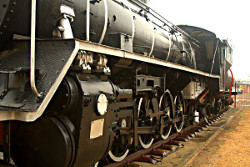The Class 19D Locomotive: A Monument to Steam History in Volksrust
In the heart of Volksrust's Market Square, a lasting tribute to the bygone era of steam locomotives stands tall. The 19D no 2696 locomotive, with its characteristic 4-8-2 wheel type, serves as a reminder of the vital role steam trains played in South Africa's rich railway history.
Before the advent of electric trains in the region, steam trains formed the backbone of the railway network. It wasn't until the completion of the electrification of the Durban-Volksrust line in 1937 that steam trains started being phased out from this area. However, the Class 19D locomotives, including the one plinthed in Volksrust, continued to have a lasting legacy.
Built in 1938 by Borsig, the 19D no 2696 at Volksrust has an interesting design element, the so-called "Vanderbilt" tender. This design, a brainchild of Cornelius Vanderbilt III in 1901, was an innovation in railway history. The cylindrical Vanderbilt tender, adopted by several American railroads, had distinct advantages. It was stronger and lighter compared to its rectangular counterparts and had a higher fuel holding capacity in relation to its surface area. In the South African context, this design efficiently carried both water and coal for the locomotives.
The Class 19D steam locomotives, often affectionately nicknamed "Dolly", were not just restricted to South Africa. They saw extensive service on every system of the South African Railways (SAR) and were among the last steam locomotives to retire. From 1937 to 1949, 235 of these locomotives were introduced to service by the SAR. And between 1951 and 1955, 33 more Class 19D locomotives were built, serving operators outside South Africa, including the Rhodesia and Angolan railways, and the Nkana and Wankie mines. This made the Class 19D the most produced South African steam locomotive type ever.
The journey of the Class 19D locomotives began with Colonel F.R. Collins, the Chief Mechanical Engineer (CME) of SAR from 1922 to 1929. Collaborating with Test Engineer M.M. Loubser, who later became the CME from 1939 to 1949, the duo laid the groundwork for the Class 19 design in the late 1920s. By 1937, W.A.J. Day, who served as CME from 1936 to 1939, put forth the Class 19D design, refining its predecessor, the Class 19C, with the introduction of piston valves and Walschaerts valve gear instead of rotary cam poppet valve gear.
Between 1937 and 1955, an impressive total of 268 Class 19D locomotives were produced. These trains were manufactured in various parts of the world - from Czechoslovakia, Germany, to the United Kingdom - and were shipped to the SAR and several other operators in Southern Africa.
Today, as visitors gaze upon the 19D locomotive in Volksrust's Market Square, it stands not just as a monument of metal and steam but as a symbol of innovation, collaboration, and the indomitable spirit of progress.
